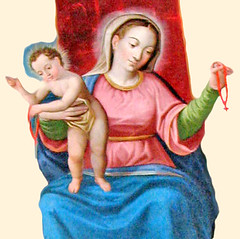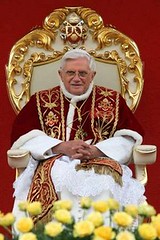A Sequence for Christmas

Exsultet fidelis chorus.
Alleluia.
Regem regum
Intactae profudit thorus:
Res miranda.
Angelus Consilii
Natus es de Virgine:
Sol de stella.
Sol occasum nesciens,
Stella semper rutilans,
Semper clara.
Sicut sidus radium,
Profert Virgo Filium,
Pari forma.
Neque sidus radio,
Neque mater Filio,
Fit corrupta.
Cedrus alta Libani
Conformatur hyssopo,
Valle nostra;
Verbum ens Altissimi
Corporari passum est,
Carne sumpta.
Isaias cecinit,
Synagoga meminit,
Nunquam tamen desinit
Esse caeca.
Si non suis Vatibus,
Credat vel gentilibus:
Sibylinis versibus
Haec predicta.
Infelix, propera,
Crede vel vetera:
Cur damnaberis,
Gens misera?
Quem docet littera,
Natum considera;
Ipsum genuit puerpera.
Alleluia."
'Let the faithful choir
Joyfully rejoice,
Alleuia!
The womb of the undefiled one
Hath brought forth the King of kings:
A thing of wonder.
The Angel of the counsel
Is born of the Virgin:
The Sun of the Star.
The Sun that knows no setting,
The Star that is ever shining,
Ever bright.
As the star its ray,
In like manner
The Virgin brings forth her Son.
Neither the star by its ray,
Nor the mother by her Son,
Becomes defiled.
The lofty cedar of Lebanon
Is conformed to the hyssop
In our valley.
The Word, the Being of the Most High,
Has deigned to become incarnate,
Having assumed flesh.
Isaiah foretold it,
The Synagogue remembers it,
Yet never does she cease to be blind.
If not her own prophets,
Let her at least believe the Gentiles;
In the Sibylline verses
These things are predicted.
O unhappy one, hasten;
At least believe the ancient things.
O wretched race,
Why will you be condemned?
Behold the Child of whom
The Scripture teaches:
The mother hath brought him forth.
Alleluia!'
In the first verse, the chorus of the faithful are set up in opposition to the those mentioned later in the hymn who are incredulous in the face of this great marvel of Christ's birth. Christ is refered to as King of kings (cf 1 Tim 6:15) and the "thing of wonder" referred to is of course, the Virgin Birth.
In the second verse, Christ is called the Angel of the great counsel because he is the Messenger (Angelus) sent to make known to the human race the New Law (Magnum consilium) of love in all its fullness. The frequent reference to Christ as the Sun has foundation in two prophecies, Zechariah 3:8 and Malachi 4:2. The reference to Mary as the Star is based on the prophecy: "A Star shall rise out of Jacob" (Num 24:17) and St Bernard thus uses it. Since the lineage of Joseph and Mary was believed to have been the same, Mary is rightly called the Star of Jacob. In this verse, Christ is the light that never fails (cf Ecclesiasticus 24:6) whose glory falls upon Our Lady who is the Star. Mary's glory is always the reflected glory of her divine Son.
The third stanza gives the beautiful explanation of the Virgin Birth which St Bernard uses again in the Feast of the Most Holy Name of Mary: "The light of the star takes nothing away from the star itself, and the birth of her Child took nothing away from the virginity of Mary." We should note here that the metaphor is used differently from the verse above. In this verse, the Star itself gives off rays of light and this is used as an image of giving birth, whereas the previous verse alludes to the Star as a reflection of the eternal splendour of the Sun.
The fourth verse portrays the condescension of the Incarnation. Christ is the cedar of Lebanon, to whom is usually applied the words "I will take the marrow of the high cedar" (Ezekiel 17:22). In the psalms a comparison with the cedar of Lebanon represents a Jewish conception of that which is highest, noblest, best. Mary is the hyssop; the common hyssop is a small shrub. As such, we are to understand the sublime humility of a mighty cedar descending to the level of a lowly shrub; God becoming man. The valley referred to in this stanza merely emphasises the lowliness of our state and has echoes of the "vale of tears" in the Salve Regina, which is the state of the human condition.
In the fifth verse, there is a plea to the Jewish people to accept their own or the pagan prophecies. Isaiah is the prophet of the Nativity of Christ, par excellence and his prediction of the Virgin Birth (cf Isa 7:14) is read during Advent and in the Office of the season. The Synagogue refers to the group of leaders who were the recognized spiritual guides of the people of Israel. As such, it represents the Jewish nation. In Matt 15:14, Christ calls these leaders "the blind guides of the blind", hence the allusion to blindness here. The Sibylline verses are collections of supposed prophecies emanating from pagan seers or Sibyls. They are most famously portrayed on the roof of the Sistine chapel. These verses were widely circulated in the Middle Ages and regarded as true prophecies albeit from pagan seers.
The final verse speaks of punishment for all who reject Christ (cf Deut 28:62-68; Dan 9:26-27; Hosea 3:4) or refuse to believe in Him; as such it is a plea for all to turn to Him and be saved. These words of the Sequence hymn must be put into context, written as they were in the 12th century or even earlier, and we ought to recall the declaration of the Second Vatican Council: "As Holy Scripture testifies, Jerusalem did not recognize the time of her visitation, nor did the Jews in large number, accept the Gospel; indeed not a few opposed its spreading. Nevertheless, God holds the Jews most dear for the sake of their Fathers; He does not repent of the gifts He makes or of the calls He issues-such is the witness of the Apostle. In company with the Prophets and the same Apostle, the Church awaits that day, known to God alone, on which all peoples will address the Lord in a single voice and "serve him shoulder to shoulder"." (Nostra Aetate, 4)
Today, as we celebrate the appearing of our Saviour, when angels and archangels rejoice and the righteous exult with joy crying out "Glory to God in the highest!" (cf Magnificat antiphon, Second Vespers), let us pray for greater unity in our world, peace among nations and an increase in love, as we find the fulfillment of every human longing and desire in Jesus Christ, our Emmanuel, God's eternal Word made Flesh. May the Lord, the Angel of Great Counsel open the eyes of us all to see just how great and wonderful is the salvation He holds out to us.
The image above of the Virgin and Child is taken from a 19th century hand-illuminated book in the archives of Ushaw College.







0 Comments:
Post a Comment
<< Home